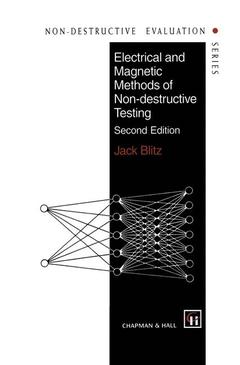Electrical and Magnetic Methods of Non-destructive Testing (2nd Ed., 2nd ed. 1997) Non-Destructive Evaluation Series, Vol. 3
Langue : Anglais

This book is intended to help satisfy an urgent requirement for up-to date comprehensive texts at graduate and senior undergraduate levels on the subjects in non-destructive testing (NDT). The subject matter here is confined to electrical and magnetic methods, with emphasis on the widely used eddy current and magnetic flux leakage methods (including particle inspection), but proper attention is paid to other techniques, such as microwave and AC field applications, which are rapidly growing in importance. Theoretical analyses relating to the various methods are discussed and the depths of presentation are often governed by whether or not the information is readily available elsewhere. Thus, for example, a considerable amount of space is devoted to eddy current theory at what the author considers to be a reasonable standard and not, as usually experienced, in either a too elementary manner or at a level appreciated only by a postgraduate theoretical physicist. The inclusion of the introductory chapter is intended to acquaint the reader with some of the philosophy of NDT and to compare, briefly, the relative performances of the more important methods of testing.
1 Introduction.- 1.1 General considerations.- 1.2 Methods of non-destructive testing.- 1.3 Electrical and magnetic methods.- 1.4 Choosing a method.- 1.5 Automation in non-destructive testing.- 1.6 Conclusion.- 1.7 Further reading.- 2 Fundamental theory.- 2.1 General considerations.- 2.2 Electrical conductivity and resistivity.- 2.3 Dielectric materials.- 2.4 Electromagnetism.- 2.5 Alternating currents.- 2.6 Circuit networks.- 2.7 Ferromagnetic materials.- 2.8 Electromagnetic radiation.- 3 Magnetic methods.- 3.1 Introduction.- 3.2 Flux leakage methods.- 3.3 Magnetic particle inspection (MPI).- 3.4 Magnetic tape inspection (magnetography).- 3.5 Quantitative flux leakage detectors.- 3.6 Quantitative flux leakage applications.- 3.7 Magnetization and hysteresis methods.- 3.8 Less common magnetic techniques.- 4 Eddy current principles.- 4.1 Introduction.- 4.2 Coils encircling defect-free metal rods.- 4.3 Coils encircling defect-free metal tubes.- 4.4 Internal coaxial coils in defect-free metal tubes.- 4.5 Coils scanning the surfaces of defect-free conductors.- 4.6 Defect modelling.- 5 Eddy current methods.- 5.1 General considerations.- 5.2 Fundamental measurements.- 5.3 Probe design.- 5.4 Requirements for eddy current measurements.- 5.5 Basic eddy current tests: measurements.- 5.6 Basic eddy current defect detection and sizing.- 6 More advanced eddy current testing methods.- 6.1 Automatic testing.- 6.2 Multifrequency testing.- 6.3 Remote field testing.- 6.4 Lift-off flaw detection.- 6.5 Pulsed eddy current testing.- 6.6 Microwave eddy current testing.- 6.7 Fibre-reinforced plastics.- 6.8 Neural networks.- 6.9 Defect imaging.- 7 Microwave methods.- 7.1 Introduction.- 7.2 Microwave radiation.- 7.3 Microwave instrumentation.- 7.4 Microwave measurements.- 8 Miscellaneous methods.- 8.1 General considerations.- 8.2 Potential drop methods.- 8.3 Resistance strain gauges.- 8.4 Electrified particle testing.- 8.5 Direct measurement of resistance or capacitance.- Appendices.- A Notes on units.- B Standards.- C Bessel functions.- D BASIC programs for predicting impedence components.- D.1 Coils encircling electrically conducting cylindrical rods.- D.2 Coils encircling electrically conducting cylindrical tubes.- D.3 Air-cored: scanning the surfaces of electrical conductors.- References.
This fully revised and thoroughly updated new edition provides a comprehensive account of the subject. The requirements for non-destructive testing are debated along with the criteria for the choice of a given method. This is followed by a summary of the general theory relating to electrical and magnetic testing techniques and a discussion of specific methods. New features of this edition include : coverage of recent developments in magnetic methods of testing, such as SQUID magnetometry and Barkhausen emission testing , a new chapter exploring the latest developments in eddy current testing such as improvements in probe design, the use of neural networks and defect imaging, especially with the use of magneto-optic method (MOI) , a more detailed discussion of RADAR and potential drop meth
Date de parution : 10-2012
Ouvrage de 261 p.
15.5x23.5 cm
Mots-clés :
concrete; design; development; emission; engine; metals; microwave; modeling; network; neural networks; plastics; radar; structure; structures; testing
© 2024 LAVOISIER S.A.S.



